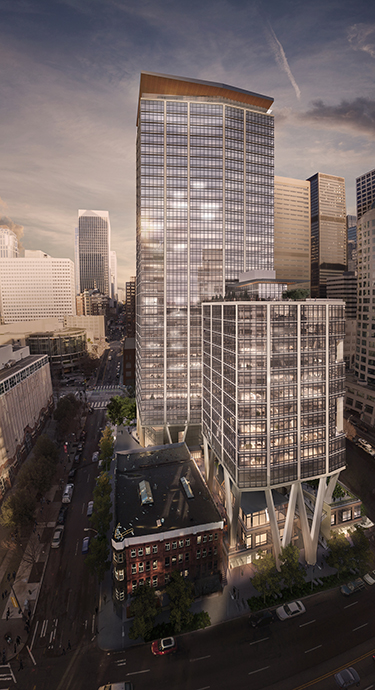|
Subscribe / Renew |
|
|
Contact Us |
|
| ► Subscribe to our Free Weekly Newsletter | |
| home | Welcome, sign in or click here to subscribe. | login |
Real Estate
| |
 |
June 23, 2016
High rise vs. low rise — which is greener?
WSP/Parsons Brinckerhoff

Marseille
|
At last count, there were 16 tall towers going up in Seattle. Our high-rise boom is clearly following the global trend of increasing urbanization.
The data suggests that while in 2014 more than half of the world’s population lived in urban areas, by 2050 this is predicted to rise to two-thirds, with 2.5 billion new city dwellers — the equivalent of constructing five cities the size of Beijing every year until then.
But, we are actually living at the crossroads of not one but two significant trends: urbanization and climate change. Cities are responding to the trend toward urbanization by reaching for the sky. And many argue this is also a more sustainable forward path than a continuing horizontal expansion.
At first blush, high-rise buildings enable more people to live, work and spend their leisure time or access public services in a relatively small area, and that drives more efficient mass transportation. So, from an urban planning point of view, towers are very sustainable.
But, can a high-rise building ever truly be greener than a low-rise building in terms of energy consumption?
Viewed with business-as-usual thinking and technology, the simple answer is no. If you are going to wash clothes or take a shower on the 40th floor, you have to bring the water up there. When you come home from work or shopping and hop on an elevator, you consume more energy relative to if you lived on the ground floor.
Standing out on the skyline, a tall building is more exposed to solar heat gain, and can require greater amounts of cooling to maintain a comfortable temperature. While Seattle summers may be getting warmer, there are still good opportunities to design effective natural ventilation, and full passive cooling without any air conditioning for low-rise buildings. In contrast, our tallest buildings create design challenges relative to low-rise buildings to even mechanically ventilate, much less use operable windows to naturally ventilate.
Energy demands tend to be higher for towers, and strategies developed for low-rise buildings may not be effective for high-rises.
Yet, at a minimum we are being challenged by an increasingly stringent Seattle energy code to consider what’s possible. And unique challenges aside, those do not mean a designer cannot put knowledge, skills and creativity to work and devise a high-rise building that uses dramatically less energy than its peers.
In Portland, the Edith Green-Wendell Wyatt Federal Building is a recent award-winning example of what is possible in a multi-tenant high rise. The Stone34 project in Seattle, developed and built by Skanska, while not a high-rise tower, established a benchmark for high performance. That spirit has carried forward as Skanska is now developing a commercial high-rise tower at Second and University in our urban core.
Opening windows
As with any other building, a more sustainable outcome starts with evaluating what is specific and unique about a project and its site, and pursuing appropriate passive strategies that result in improved energy performance. For a high-rise building, that means first focusing on improving the facade — ideally considering building orientation — to reduce the need for heating and cooling. And while reflecting as much of the sun’s heat away as possible is the summer goal, the design also needs to make the best use of natural light.
The higher winds and other climatic variations you find between the street and penthouse in a high rise present both a challenge and an opportunity. Seattleites still largely prefer the option to open their windows and enjoy fresh air in abundance when weather permits. Whereas in a sealed building, you have to constantly pump in fresh air and exhaust stale air, using more energy.
Opening an upper story window is not an easy thing to do on a high rise. We have to design the facade so you can get the fresh air we want but the wind doesn’t blow the window off or blow a gale through your home or office. So, the aim is to provide the ability to shut down the air-conditioning when outdoor conditions allow, as opposed to being forced to use it all the time.
With passive strategies at the facade in play, synergies then open up for the economic use of efficient mechanical systems. Better facades result in smaller systems, and those mean additional rentable floor space and either potentially higher ceilings as an amenity, or the ability to include more floors in a building within a zoned height limit.
With the evaluation of more efficient systems comes yet another opportunity in high-rise developments. Where those buildings combine offices, homes and other uses, it can enable a more efficient use of resources. Residential buildings have different usage patterns than offices. This presents opportunities to share energy and equipment. A clear synergy results when waste heat from office cooling can be collected and stored during the day and used later as a source for hot water and/or heating for apartments.
As we better understand the energy balance between available resources and building needs, appropriate strategies to accomplish this may be implemented.
Getting to net zero?
Perhaps the last question when considering a 21st century high-rise building is whether it can ever achieve net zero energy. For an urban high rise, its relatively tiny roof area in relation to its size rules out receiving a large benefit using conventional technologies for generating renewable energy, such as photovoltaic or solar thermal panels. The use of building integrated photovoltaics at the cladding of the facade, while helpful, is not as mature or efficient, and within a developing urban core year-long access to the sun is not a given.
And, even if enough renewable energy could be deployed on a high rise to offset energy demand, Seattle’s downtown uses a networked electrical grid for reliability, so it cannot today safely accept back-fed energy generated on site.
Fortunately, new district paradigms are emerging that are practical, achievable and localized. They take us beyond thinking in terms of site boundaries when considering options for our building projects. The concept of heat sharing — harvesting neighboring energy resources that would otherwise be wasted — is one such opportunity, and can enable the step change needed to achieve high-performance outcomes.
A recent example of heat sharing is Amazon using waste heat from Clise Properties’ data center for use in its neighboring high-rise office tower.
Urbanization and climate change is our future. With planning, good design and future thinking, we can consider both and deliver great projects in our great city.
Tom Marseille is a senior vice president and director of sustainability for WSP/Parsons Brinckerhoff in Seattle.
Other Stories:
- In Pioneer Square, reality replaces myth
- Seattle’s building boom pushes apartment evolution
- Look to the water for affordable housing
- For older apartments, choose renovation over demolition
- Capturing the past in today’s buildings
- Is dead retail space bringing your building down?
- Ballard’s Nordic roots come out at Odin Apartments
- New lease on life for iconic First Hill apartment
- Going beyond the mock-up with virtual reality
- Re-energizing an old power plant site on Lake Washington



